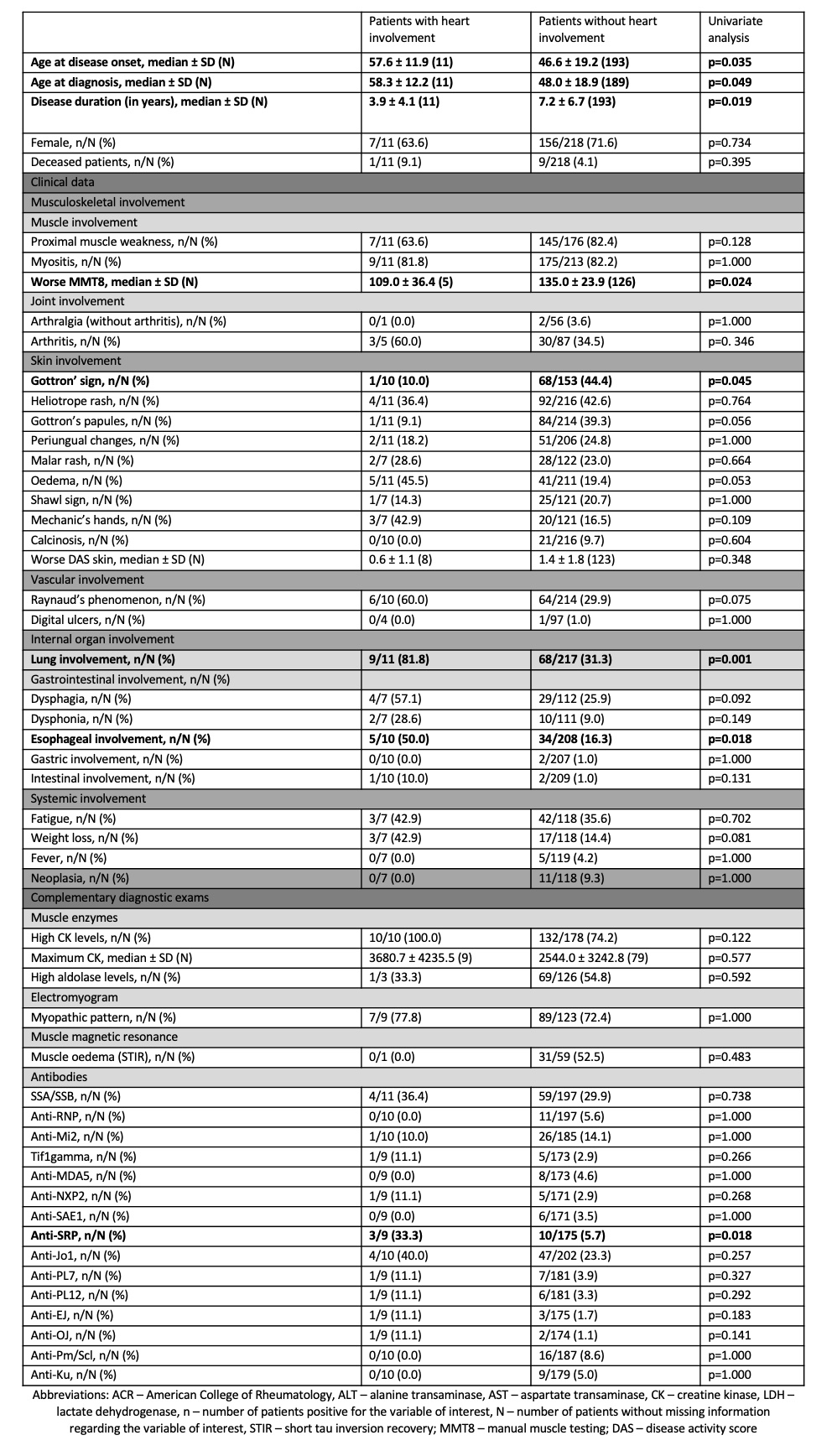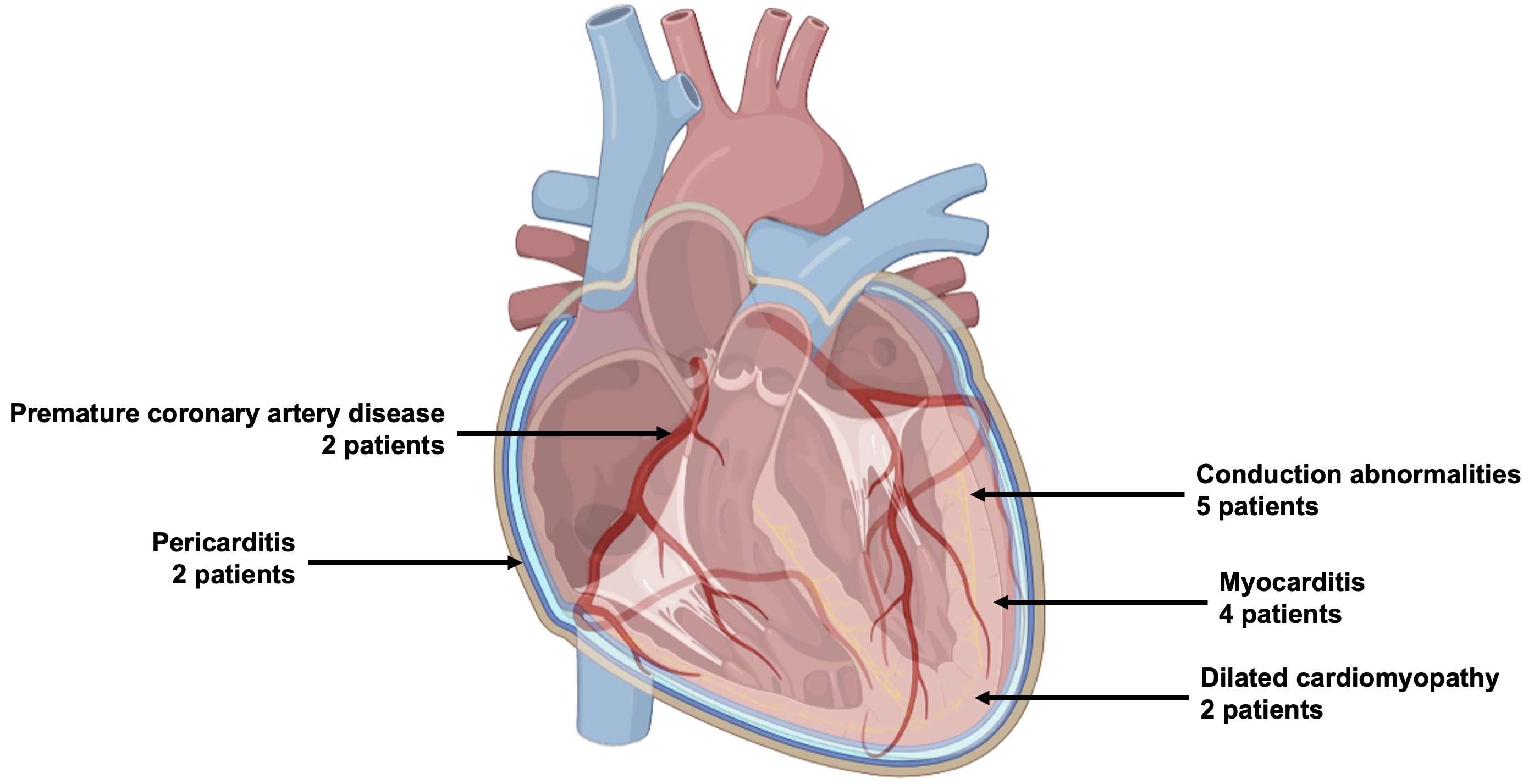Back
Poster Session A
Myopathic rheumatic diseases (polymyositis, dermatomyositis, inclusion body myositis)
Session: (0150–0180) Muscle Biology, Myositis and Myopathies Poster I
0171: Cardiac Involvement in Idiopathic Inflammatory Myopathies: When Should We Look for It?
Saturday, November 12, 2022
1:00 PM – 3:00 PM Eastern Time
Location: Virtual Poster Hall
- MB
Matilde Bandeira, MD
Centro Hospitalar Universitário Lisboa Norte
Lisboa, Portugal
Abstract Poster Presenter(s)
Matilde Bandeira1, Eduardo Dourado1, Ana Teresa Melo1, Patricia Martins2, Vanessa Fraga3, José Luís Ferraro4, André Saraiva5, Marlene Sousa6, Hugo Parente7, Catarina Soares8, Ana Margarida Correia9, Diogo Esperança Almeida9, Sara Paiva Dinis10, Ana Pinto11, Filipe Pinheiro12, Maria Rato12, Tiago Beirão13, Beatriz Samões13, Bernardo Santos14, Carolina Mazeda15, Ana Teodósio Chícharo16, Margarida Faria17, Agna Neto17, Helena Lourenço18, Luísa Brites19, Marília Rodrigues19, Joana Silva-Dinis20, João Madruga-Dias21, Filipe Araújo22, Nádia Martins23, Maura Couto23, Ana Valido24, Maria José Santos25, Sofia Barreira1, João Eurico Fonseca1 and Raquel Campanilho-Marques1, 1Serviço de Reumatologia, Centro Hospitalar Universitário Lisboa Norte, Centro Académico de Medicina de Lisboa (CAML), Lisboa, Portugal; Unidade de Investigação em Reumatologia, Instituto de Medicina Molecular, Faculdade de Medicina, Universidade de Lisboa, CAML, Lisboa, Portugal, 2Rheumatology department, Centro Hospitalar e Universitário de Lisboa Norte, Centro Académico de Medicina de Lisboa, Lisboa, Portugal, 3Serviço de Reumatologia, Hospital Beatriz Ângelo, Almada, Portugal, 4Serviço de Reumatologia, Hospital Beatriz Ângelo, Loures, Portugal, 5Rheumatology department, Centro Hospitalar e Universitário de Coimbra, Coimbra, Portugal, 6Serviço de Reumatologia, Centro Hospitalar Universitário de Coimbra, Coimbra, Portugal, 7Rheumatology department, Unidade Local de Saúde do Alto Minho, Ponte de Lima, Portugal, 8Rheumatology department, Unidade Local de Saúde do Alto Minho, Ponte de Lima, Viana do Castelo, Portugal, 9Serviço de Reumatologia, Hospital de Braga, Braga, Portugal, Braga, Portugal, 10Rheumatology department, Unidade Local de Saúde da Guarda - Hospital Sousa Martins, Guarda, Portugal, 11Local Health Unit of Guarda, Barcelos, Portugal, 12Rheumatology Department, Centro Hospitalar Universitário de São João, Porto, Portugal, 13Rheumatology Department, Centro Hospitalar de Vila Nova de Gaia / Espinho, Vila Nova de Gaia, Portugal, 14Serviço de Reumatologia, Centro Hospitalar do Baixo Vouga, Aveiro, Portugal, 15Centro Hospitalar Baixo Vouga, Ovar, Portugal, 16Serviço de Reumatologia, Centro Hospitalar Universitário do Algarve, Faro, Portugal, 17Serviço de Reumatologia, Hospital Nélio Mendonça, Serviços de Saúde da Região Autónoma da Madeira, Funchal, Portugal, 18Serviço de Reumatologia, Centro Hospitalar de Lisboa Ocidental, Lisboa, Portugal, 19Serviço de Reumatologia, Centro Hospitalar de Leiria, Leiria, Portugal, Leiria, Portugal, 20Serviço de Reumatologia, Centro Hospitalar Universitário de Lisboa Central, Lisboa, Portugal, 21Rheumatology Service, Centro Hospitalar Médio Tejo, Tomar, Portugal, 22Rheumatology and Osteoporosis Unit, Hospital de Sant´Ana, SCML, Lisboa, Portugal, 23Rheumatology department, Centro Hospitalar Tondela-Viseu, Viseu, Portugal, 24Serviço de Reumatologia, Unidade Local de Saúde do Litoral Alentejano, Santiago do Cacém, Portugal, 25Hospital Garcia de Orta, Almada, Charneca da Caparica, Portugal
Background/Purpose: Idiopathic inflammatory myopathies (IIM) are a group of rare disorders that can affect the heart. It is unclear which patients are at higher risk. Anti-signal recognition particle (anti-SRP) antibody has been inconsistently suggested as a risk factor. This work aims to find predictors of heart involvement in IIM.
Methods: Multicenter open cohort study, including patients registered in the IIM module of the Rheumatic Diseases Portuguese Register (Reuma.pt/Myositis) until January 2022. Patients without heart involvement information were excluded. Myo(peri)carditis, dilated cardiomyopathy, conduction abnormalities and/or premature coronary artery disease were considered. Data from continuous variables are presented as mean ± standard deviation. Univariate analysis was performed using chi-square, Fisher's exact, Mann-Whitney or t-test, as appropriate. Independent predictors of cardiac involvement, adjusted for sex and age at diagnosis, were identified through binomial logistic regression. The linearity of the continuous variables was assessed via the Box-Tidwell procedure. Correlated variables, cases with missing information and outliers were excluded from the multivariate analysis to assure the validity of the regression.
Results: 229 patients were included, 163 (71.2%) females. Patients were classified as having definite [56/115 (48.7%)], likely [23/115 (20.0%)], or possible [2/115 (1.7%)] IIM by 2017 EULAR/ACR classification criteria. Cardiac involvement was present in 11 (4.8%) patients (Figure 1), of whom 42.9% were classified as likely and 57.1% as definite IIM. The mean age at disease onset was 47.1 ± 19.0 years, the mean age at diagnosis was 48.6 ± 18.7 years, and the mean disease duration at the last follow-up was 7.0 ± 6.6 years. Compared to other IIM patients (Table 1), patients with cardiac involvement were older at disease onset (57.6 ± 11.9 vs 46.6 ± 19.2 years, p=0.035) and diagnosis (58.3 ± 12.2 vs 48.0 ± 18.9 years, p=0.049), and had a shorter disease duration at the last follow-up (3.9 ± 4.1 vs 7.2 ± 6.7 years, p=0.019). Clinically, patients with cardiac involvement had a lower manual muscle testing score (MMT), comparing the lowest value throughout follow-up, and more frequently had esophageal [5/10 (50.0%) vs 34/208 (16.3%), p=0.018] and lung involvement [9/11 (81.8%) vs 68/217 (31.3%), p=0.001]. Conversely, this group less frequently had Gottron's sign [1/10 (10.0%) vs 68/153 (44.4%), p=0.045]. Anti-SRP antibodies were more commonly identified in patients with cardiac involvement [3/9 (33.3%) vs 10/175 (5.7%), p=0.018]. No differences were found between the two groups for other demographical or clinical data or serum biomarkers. In the multivariate analysis, lung involvement (OR 7.064, 95%CI: 1.246-40.057, p=0.027) and positivity of anti-SRP antibodies (OR 7.886, 95%CI: 1.333-46.666, p=0.023) were confirmed as independent predictors of heart involvement in IIM patients, regardless of sex and age at diagnosis.
Conclusion: Lung involvement and anti-SRP antibodies were independent predictors of heart involvement in our cohort of IIM patients. We suggest considering a closer screening for heart involvement in these patients. Table 1 – Clinical and serological features of patients with and without heart involvement
Table 1 – Clinical and serological features of patients with and without heart involvement
 Figure 1 – Types of heart involvement in our cohort. Some patients had more than one manifestation
Figure 1 – Types of heart involvement in our cohort. Some patients had more than one manifestation
Disclosures: M. Bandeira, None; E. Dourado, None; A. Melo, None; P. Martins, None; V. Fraga, None; J. Ferraro, None; A. Saraiva, None; M. Sousa, None; H. Parente, None; C. Soares, None; A. Correia, None; D. Esperança Almeida, None; S. Paiva Dinis, None; A. Pinto, None; F. Pinheiro, None; M. Rato, None; T. Beirão, None; B. Samões, None; B. Santos, None; C. Mazeda, None; A. Teodósio Chícharo, None; M. Faria, None; A. Neto, None; H. Lourenço, None; L. Brites, None; M. Rodrigues, None; J. Silva-Dinis, None; J. Madruga-Dias, None; F. Araújo, None; N. Martins, None; M. Couto, None; A. Valido, None; M. Santos, AbbVie/Abbott, AstraZeneca, pfizer, Novartis, Eli Lilly; S. Barreira, None; J. Fonseca, AbbVie/Abbott, Biogen, Bristol-Myers Squibb(BMS), Janssen, Eli Lilly, Medac, Merck/MSD, Novartis, Pfizer, UCB; R. Campanilho-Marques, None.
Background/Purpose: Idiopathic inflammatory myopathies (IIM) are a group of rare disorders that can affect the heart. It is unclear which patients are at higher risk. Anti-signal recognition particle (anti-SRP) antibody has been inconsistently suggested as a risk factor. This work aims to find predictors of heart involvement in IIM.
Methods: Multicenter open cohort study, including patients registered in the IIM module of the Rheumatic Diseases Portuguese Register (Reuma.pt/Myositis) until January 2022. Patients without heart involvement information were excluded. Myo(peri)carditis, dilated cardiomyopathy, conduction abnormalities and/or premature coronary artery disease were considered. Data from continuous variables are presented as mean ± standard deviation. Univariate analysis was performed using chi-square, Fisher's exact, Mann-Whitney or t-test, as appropriate. Independent predictors of cardiac involvement, adjusted for sex and age at diagnosis, were identified through binomial logistic regression. The linearity of the continuous variables was assessed via the Box-Tidwell procedure. Correlated variables, cases with missing information and outliers were excluded from the multivariate analysis to assure the validity of the regression.
Results: 229 patients were included, 163 (71.2%) females. Patients were classified as having definite [56/115 (48.7%)], likely [23/115 (20.0%)], or possible [2/115 (1.7%)] IIM by 2017 EULAR/ACR classification criteria. Cardiac involvement was present in 11 (4.8%) patients (Figure 1), of whom 42.9% were classified as likely and 57.1% as definite IIM. The mean age at disease onset was 47.1 ± 19.0 years, the mean age at diagnosis was 48.6 ± 18.7 years, and the mean disease duration at the last follow-up was 7.0 ± 6.6 years. Compared to other IIM patients (Table 1), patients with cardiac involvement were older at disease onset (57.6 ± 11.9 vs 46.6 ± 19.2 years, p=0.035) and diagnosis (58.3 ± 12.2 vs 48.0 ± 18.9 years, p=0.049), and had a shorter disease duration at the last follow-up (3.9 ± 4.1 vs 7.2 ± 6.7 years, p=0.019). Clinically, patients with cardiac involvement had a lower manual muscle testing score (MMT), comparing the lowest value throughout follow-up, and more frequently had esophageal [5/10 (50.0%) vs 34/208 (16.3%), p=0.018] and lung involvement [9/11 (81.8%) vs 68/217 (31.3%), p=0.001]. Conversely, this group less frequently had Gottron's sign [1/10 (10.0%) vs 68/153 (44.4%), p=0.045]. Anti-SRP antibodies were more commonly identified in patients with cardiac involvement [3/9 (33.3%) vs 10/175 (5.7%), p=0.018]. No differences were found between the two groups for other demographical or clinical data or serum biomarkers. In the multivariate analysis, lung involvement (OR 7.064, 95%CI: 1.246-40.057, p=0.027) and positivity of anti-SRP antibodies (OR 7.886, 95%CI: 1.333-46.666, p=0.023) were confirmed as independent predictors of heart involvement in IIM patients, regardless of sex and age at diagnosis.
Conclusion: Lung involvement and anti-SRP antibodies were independent predictors of heart involvement in our cohort of IIM patients. We suggest considering a closer screening for heart involvement in these patients.
 Table 1 – Clinical and serological features of patients with and without heart involvement
Table 1 – Clinical and serological features of patients with and without heart involvement Figure 1 – Types of heart involvement in our cohort. Some patients had more than one manifestation
Figure 1 – Types of heart involvement in our cohort. Some patients had more than one manifestationDisclosures: M. Bandeira, None; E. Dourado, None; A. Melo, None; P. Martins, None; V. Fraga, None; J. Ferraro, None; A. Saraiva, None; M. Sousa, None; H. Parente, None; C. Soares, None; A. Correia, None; D. Esperança Almeida, None; S. Paiva Dinis, None; A. Pinto, None; F. Pinheiro, None; M. Rato, None; T. Beirão, None; B. Samões, None; B. Santos, None; C. Mazeda, None; A. Teodósio Chícharo, None; M. Faria, None; A. Neto, None; H. Lourenço, None; L. Brites, None; M. Rodrigues, None; J. Silva-Dinis, None; J. Madruga-Dias, None; F. Araújo, None; N. Martins, None; M. Couto, None; A. Valido, None; M. Santos, AbbVie/Abbott, AstraZeneca, pfizer, Novartis, Eli Lilly; S. Barreira, None; J. Fonseca, AbbVie/Abbott, Biogen, Bristol-Myers Squibb(BMS), Janssen, Eli Lilly, Medac, Merck/MSD, Novartis, Pfizer, UCB; R. Campanilho-Marques, None.

